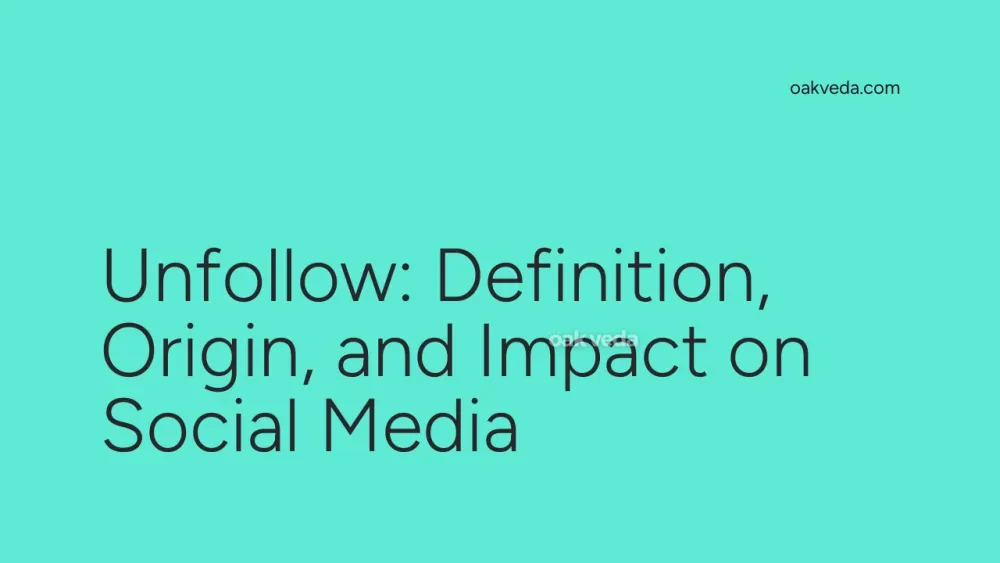
What is Unfollow?
Unfollowing is a common action on social media platforms that allows users to stop receiving updates from specific accounts they previously followed. When you unfollow someone, their posts no longer appear in your feed, giving you more control over the content you consume. This feature is essential for managing your social media experience and curating your digital environment.
Origin and Development of Unfollow
The concept of unfollowing emerged alongside the rise of social media platforms in the mid-2000s. As networks like Twitter and Facebook gained popularity, users needed a way to manage their growing list of connections. The unfollow feature was introduced to provide this control without the finality of unfriending or blocking.
Initially, unfollowing was a simple on/off switch. However, as social media evolved, so did the unfollow feature. Many platforms now offer more nuanced options, such as muting or snoozing accounts, which allow users to temporarily reduce content from specific sources without completely unfollowing them.
How Unfollow Works
Unfollowing is typically a straightforward process:
- Navigate to the profile you wish to unfollow
- Look for the "Following" or "Subscribed" button
- Click or tap the button to unfollow
- Confirm your action if prompted
Once you've unfollowed an account, their posts will no longer appear in your feed. However, it's important to note that unfollowing is not the same as blocking. The unfollowed account can still view your profile and interact with your content unless you've set additional privacy restrictions.
Types of Unfollowing
While the basic concept remains the same, different platforms offer various unfollowing options:
- Hard Unfollow: Completely removing an account from your follow list
- Soft Unfollow: Using features like mute or snooze to temporarily stop seeing content
- List-based Unfollow: Removing accounts from specific lists or categories without unfollowing entirely
- Algorithm-based Unfollow: Some platforms allow you to indicate that you want to see less content from certain accounts without explicitly unfollowing them
Popular Examples of Unfollow Features
Different social media platforms have implemented the unfollow feature in unique ways:
- Twitter: Offers a straightforward unfollow button and a "soft unfollow" option through muting
- Instagram: Provides an unfollow button and the ability to mute posts or stories separately
- Facebook: Allows unfollowing while remaining friends, as well as snoozing accounts for 30 days
- LinkedIn: Enables users to unfollow connections without removing them from their network
Impact of Unfollowing on Social Media Culture
Unfollowing has significantly impacted how users interact with social media:
- Content Curation: Users can tailor their feeds to their interests, improving overall experience
- Digital Decluttering: Unfollowing helps reduce information overload and digital noise
- Emotional Well-being: By unfollowing negative or stressful content, users can maintain a healthier online environment
- Privacy Management: Unfollowing provides a subtle way to distance oneself from certain accounts without confrontation
Controversies Surrounding Unfollowing
While unfollowing is generally accepted, it's not without controversy:
- Social Pressure: Some users feel obligated to follow back or maintain connections, making unfollowing awkward
- Algorithmic Impact: Unfollowing can affect an account's visibility and reach, potentially impacting influencers and businesses
- Silent Treatment: Unfollowing is sometimes seen as a passive-aggressive way to end relationships or express disapproval
How Brands and Influencers Use Unfollow
Brands and influencers must navigate the unfollow feature carefully:
- Audience Management: They use unfollow data to understand audience preferences and adjust content strategies
- Engagement Tactics: Some employ "follow/unfollow" strategies to gain attention, though this is often frowned upon
- Competitor Analysis: Brands may unfollow competitors to maintain a curated feed focused on their industry niche
Future Trends Related to Unfollowing
As social media continues to evolve, we can expect to see:
- More Granular Controls: Platforms may offer even more nuanced ways to customize content visibility
- AI-Powered Unfollowing: Algorithms could suggest accounts to unfollow based on engagement patterns
- Temporary Unfollowing: Features that allow users to take "breaks" from certain content for specified periods
- Cross-Platform Management: Tools that help users manage their following lists across multiple social networks
FAQs about Unfollowing
Q: Can someone tell if I've unfollowed them? A: Generally, users are not notified when they're unfollowed. However, they may notice if they check their follower count or list.
Q: Does unfollowing someone unfollow me from their account? A: No, unfollowing is a one-way action. The other person will still follow you unless they choose to unfollow you as well.
Q: Can I see posts from an unfollowed account? A: Yes, you can still visit their profile or see their content if it's shared by mutual connections or appears in search results.
Q: Is there a limit to how many accounts I can unfollow? A: Some platforms impose daily limits on unfollowing to prevent spam and manipulative behavior. These limits vary by platform and account type.
In conclusion, the unfollow feature has become an integral part of social media, empowering users to curate their digital experience. As platforms continue to evolve, understanding and effectively using the unfollow function will remain crucial for maintaining a balanced and enjoyable social media presence.
You may be interested in:
- Organic Reach: Definition, Origin, and Impact on Social Media
- TikTok Reactions: Definition, Origin, and Impact
- Mute: Definition, Origin, and Impact on Social Media
- Brand Ambassador: Definition, Origin, and Impact
- Nano-Influencer: Definition, Origin, and Impact
- Menty B: Definition, Origin, and Impact on Social Media

